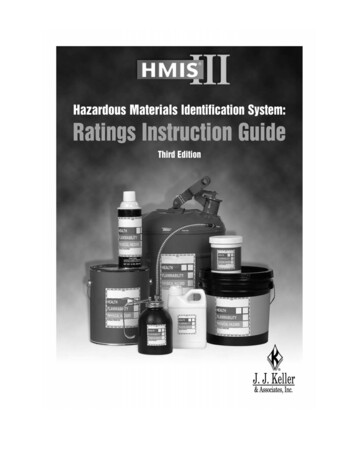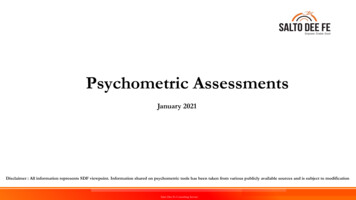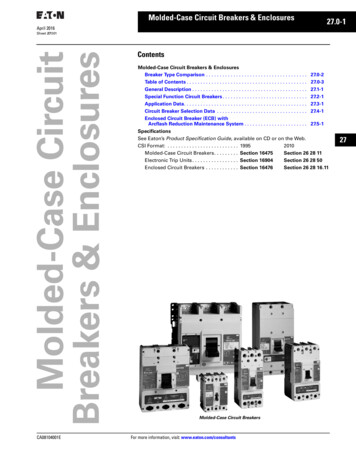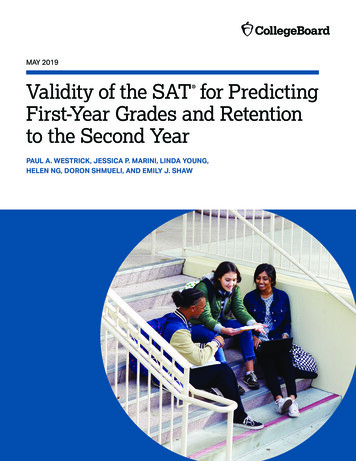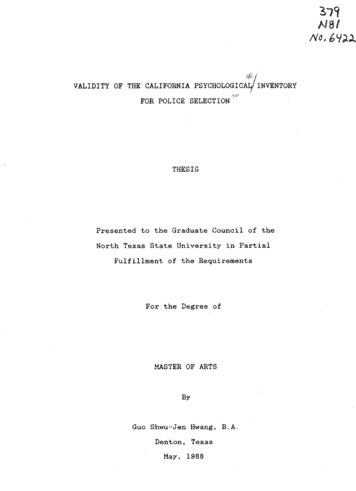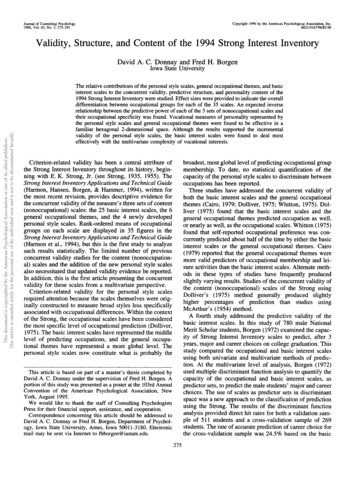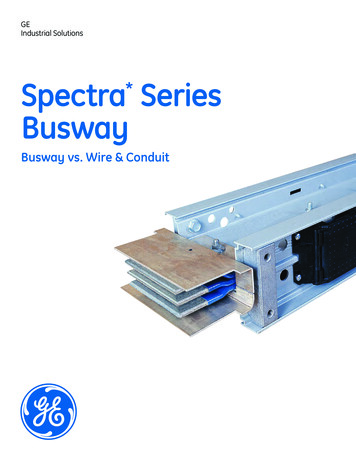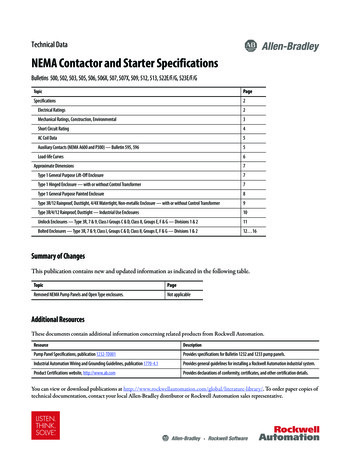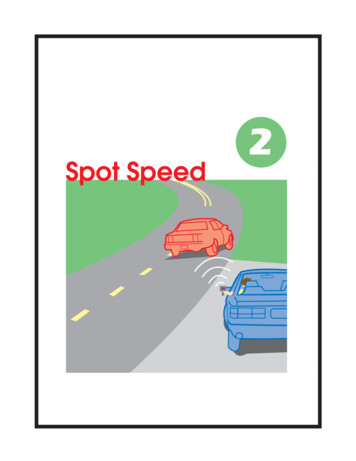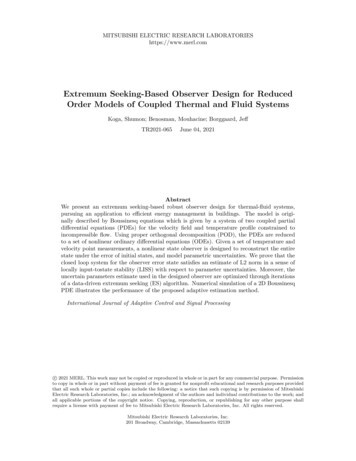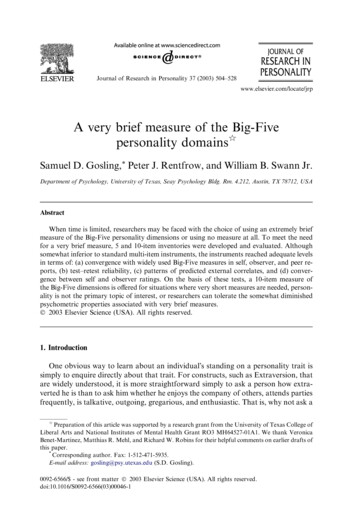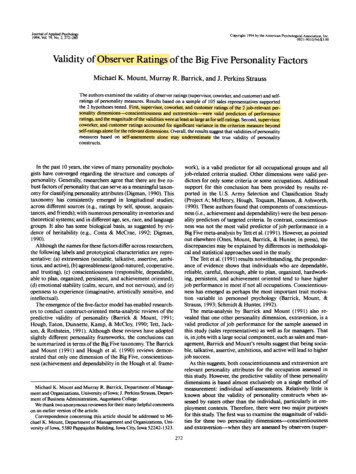
Transcription
Journal of Applied Psychology1994, Vol. 79, No. 2, 272-280Copyright 1994 by the American Psychological Association, Inc.002I-9010/94/S3.00Validity of Observer Ratings of the Big Five Personality FactorsMichael K. Mount, Murray R. Barrick, and J. Perkins StraussThe authors examined the validity of observer ratings (supervisor, coworker, and customer) and selfratings of personality measures. Results based on a sample of 105 sales representatives supportedthe 2 hypotheses tested. First, supervisor, coworker, and customer ratings of the 2 job-relevant personality dimensions—conscientiousness and extraversion—were valid predictors of performanceratings, and the magnitude of the validities were at least as large as for self-ratings. Second, supervisor,coworker, and customer ratings accounted for significant variance in the criterion measure beyondself-ratings alone for the relevant dimensions. Overall, the results suggest that validities of personalitymeasures based on self-assessments alone may underestimate the true validity of personalityconstructs.In the past 10 years, the views of many personality psychologists have converged regarding the structure and concepts ofpersonality. Generally, researchers agree that there are five robust factors of personality that can serve as a meaningful taxonomy for classifying personality attributes (Digman, 1990). Thistaxonomy has consistently emerged in longitudinal studies;across different sources (e.g., ratings by self, spouse, acquaintances, and friends); with numerous personality inventories andtheoretical systems; and in different age, sex, race, and languagegroups. It also has some biological basis, as suggested by evidence of heritability (e.g., Costa & McCrae, 1992; Digman,1990).Although the names for these factors differ across researchers,the following labels and prototypical characteristics are representative: (a) extraversion (sociable, talkative, assertive, ambitious, and active), (b) agreeableness (good-natured, cooperative,and trusting), (c) conscientiousness (responsible, dependable,able to plan, organized, persistent, and achievement oriented),(d) emotional stability (calm, secure, and not nervous), and (e)openness to experience (imaginative, artistically sensitive, andintellectual).The emergence of the five-factor model has enabled researchers to conduct construct-oriented meta-analytic reviews of thepredictive validity of personality (Barrick & Mount, 1991;Hough, Eaton, Dunnette, Kamp, & McCloy, 1990; Tett, Jackson, & Rothstein, 1991). Although these reviews have adoptedslightly different personality frameworks, the conclusions canbe summarized in terms of the Big Five taxonomy. The Barrickand Mount (1991) and Hough et al. (1990) reviews demonstrated that only one dimension of the Big Five, conscientiousness (achievement and dependability in the Hough et al. frame-work), is a valid predictor for all occupational groups and alljob-related criteria studied. Other dimensions were valid predictors for only some criteria or some occupations. Additionalsupport for this conclusion has been provided by results reported in the U.S. Army Selection and Classification Study(Project A; McHenry, Hough, Toquam, Hanson, & Ashworth,1990). These authors found that components of conscientiousness (i.e., achievement and dependability) were the best personality predictors of targeted criteria. In contrast, conscientiousness was not the most valid predictor of job performance in aBig Five meta-analysis by Tett et al. (1991). However, as pointedout elsewhere (Ones, Mount, Barrick, & Hunter, in press), thediscrepancies may be explained by differences in methodological and statistical approaches used in the study.The Tett et al. (1991) results notwithstanding, the preponderance of evidence shows that individuals who are dependable,reliable, careful, thorough, able to plan, organized, hardworking, persistent, and achievement oriented tend to have higherjob performance in most if not all occupations. Conscientiousness has emerged as perhaps the most important trait motivation variable in personnel psychology (Barrick, Mount, &Strauss, 1993; Schmidt & Hunter, 1992).The meta-analysis by Barrick and Mount (1991) also revealed that one other personality dimension, extraversion, is avalid predictor of job performance for the sample assessed inthis study (sales representatives) as well as for managers. Thatis, in jobs with a large social component, such as sales and management, Barrick and Mount's results suggest that being sociable, talkative, assertive, ambitious, and active will lead to higherjob success.As this suggests, both conscientiousness and extraversion arerelevant personality attributes for the occupation assessed inthis study. However, the predictive validity of these personalitydimensions is based almost exclusively on a single method ofmeasurement: individual self-assessments. Relatively little isknown about the validity of personality constructs when assessed by raters other than the individual, particularly in employment contexts. Therefore, there were two major purposesfor this study. The first was to examine the magnitude of validities for these two personality dimensions—conscientiousnessand extraversion—when they are assessed by observers (super-Michael K. Mount and Murray R. Barrick, Department of Management and Organizations, University of Iowa; J. Perkins Strauss, Department of Business Administration, Augustana College.We thank two anonymous reviewers for their many helpful commentson an earlier version of the article.Correspondence concerning this article should be addressed to Michael K. Mount, Department of Management and Organizations, University of Iowa, 5380 Pappajohn Building, Iowa City, Iowa 52242-1323.272
VALIDITY OF OBSERVER RATINGSvisors, coworkers, and customers). The second was to examinewhether observer ratings explain performance variability overthat accounted for by self-ratings.Self-Ratings Versus Other RatingsHogan (1991) pointed out that there is a fundamental difference between self- and others' perspectives of a person's personality characteristics. From the observer's perspective, personality refers to a person's public self or social reputation (i.e., theway he or she is perceived by others, such as supervisors, coworkers, customers, friends, and family members). However,from the individual's perspective, personality refers to the structures, dynamics, and processes inside a person that explain whyhe or she behaves in a particular way. As this suggests, ratingsobtained from these two perspectives are quite different: Oneset of ratings is based on the observer's perspective, which incorporates information about one's reputation, whereas theother is based on a self-perspective, which incorporates less observable information about motives, intentions, feelings, andpast behaviors.According to R. Hogan (1991), a person's social reputationmay be the most appropriate perspective when the goal is prediction, as in personnel selection. Because past behavior is perhaps the best predictor of future behavior (Wernimont & Campbell, 1968), reputations (which are operationalized in traitterms based on past behavior) should be valid predictors of future behavior (job performance). This is particularly true forthose observers who interact almost exclusively with the individual in the work setting. On the basis of this reasoning, observer ratings, which capture one's public self or social reputation at work, would be expected to predict job performance aswell (or even better) than ratings based on the individual's perspective, which incorporates self-observations of past behaviorsacross settings. To our knowledge, this proposition has not yetbeen tested in the personnel selection literature.There is some evidence that self-ratings of personality havelower correlations with measures of academic achievement asthe criterion than personality ratings obtained from othersources. For example, Hough et al. (1990) conducted a comprehensive literature review of correlations between self-reports ondependability and achievement (components of conscientiousness) and education (i.e., grade point average, or GPA) of highschool and college students. Their results indicated an uncorrected correlation of. 15 for dependability and .30 for achievement, with a weighted average of .23. In contrast, other studieshave shown that the correlations between ratings made by others on conscientiousness and measures of academic achievement are relatively high. Smith (1967) found that college students' scores on the conscientiousness dimension, as rated bypeers in the first 9 weeks of classes (assessed before midtermexamination), correlated .43 (uncorrected) with first-yeargrades. Digman (1972) reported correlations in the .50s (uncorrected) between ratings by elementary school teachers on thedimension and high school GPA. Furthermore, Digman foundthat a composite formed as an unweighted sum of ratings madeby elementary school teachers on the conscientiousness dimension correlated .70 with high school GPA. In another study, Takemoto (1979) found a correlation of .65 (uncorrected) be-273tween ratings by eighth-grade teachers on conscientiousness andhigh school GPA. Overall, these findings suggest that others' ratings of conscientiousness are valid predictors of a variety of academic success criteria.Other evidence in the personality literature also suggests thatobservers' ratings of personality predict behavior as well as, ifnot better than, self-reports. The literature on objective selfawareness demonstrates that observers' judgments of personality have greater predictive validity than do self-ratings of personality about the level of awareness of one's own aggressivebehavior or affective reactions (Scheier, Buss, & Buss, 1976).John and Robbins (1991) found that the other participants in agroup discussion ranked each actor's contribution to the groupmore accurately (in comparison with highly reliable criterionrankings by psychologists) than did the actors themselves. Furthermore, Funder, Kolar, and Colvin (1992) reported that closeacquaintances predicted interpersonal behaviors as well as if notbetter than self-reports. Their results showed that personalityjudgments on the Big Five by close acquaintances were morepredictive of four independently evaluated classes of behaviorscoded from videotaped interpersonal interactions than wereself-descriptions of personality for 140 undergraduate students(each subject had ratings from two friends or roommates).Other empirical research has shown that self-ratings of personality have rather low correlations with ratings obtained fromother sources (e.g., spouses or friends): Uncorrected correlations ranged from the high .20s to .30s (Funder & Colvin,1988; Funder &Dobroth, 1987;McCrae, 1982; Watson, 1989).Three studies (Funder & Colvin, 1988; Funder & Dobroth,1987; Watson, 1989) indicated that agreement between observers' ratings was greater than the agreement between self-ratingsand observer ratings, with correlations ranging from .30s to .40s(uncorrected). In summary, this research shows that individualshave different views of their own personality than others do and,furthermore, that others' views of personality may be more predictive of behavior than self-reports.Very little is known about the validity of observer ratings ofpersonality measures in the employment context. However,given the literature cited above, it is likely that observer ratingsof job-relevant constructs will be valid predictors of job performance. Two hypotheses were tested in this study. First, we hypothesized that supervisor, coworker, and customer ratings oftwo job-relevant dimensions—conscientiousness and extraversion—would be valid predictors of sales representatives' performance. (We also examined the validity of agreeableness, emotional stability, and openness to experience when ratings wereprovided by observers as well as by the sales representativethemselves, but no hypotheses were tested.) Second, we examined whether observer ratings account for significant incremental variance in performance ratings over self-ratings. We hypothesized that for the two job-relevant dimensions, conscientiousness and extraversion, observer ratings would account forsignificant incremental variance in performance over self-ratings. This was based on previous research showing that observerratings will be valid predictors of performance and that the correlations of observer ratings with self-ratings are relatively low.Although no specific hypotheses were tested, we also examinedthis for the three other personality dimensions.
274M. MOUNT, M. BARRICK, AND J. STRAUSSMethodSubjectsSubjects were 105 sales representatives from a large appliance-manufacturing organization. They were primarily men (85%), with an averageage of 34 years, organizational tenure of 7 years, and job tenure of 4years. Each sales representative completed a self-rating on a personalityquestionnaire and also selected other individuals in the work setting tocomplete the questionnaire (generally, the supervisor, plus five coworkers and five customers). It should be noted that 13 of the subjects werenot able to obtain ratings from customers; therefore, the sample sizewas 92 rather than 105 for all analyses with customers. The averagenumber of years the sales representatives had known their raters was asfollows: for coworkers, M 2.59, SD 0.88; for supervisors, M 2.54,SD 1.29; for customers, M 2.40, SD 0.97.The purpose for obtaining these personality ratings from the varioussources was to give developmental feedback to the sales representatives.Performance ratings were obtained from both the supervisor and thecoworkers.MeasuresPersonality. Each participant completed a shortened version of thepersonality inventory developed by Goldberg (1992). This personalityinventory was developed to provide a set of Big Five factor markers thatcould replace those developed more than 30 years ago by Norman(1963). On the basis of responses obtained from 867 subjects and 205peers, Goldberg identified 20 unipolar trait adjective variables for eachdimension of the Big Five. In a follow-up study, 175 students completedthe Goldberg inventory and two other measures of the Big Five: theNEO Personality Inventory (NEO-PI; Costa & McCrae, 1985) and theHogan Personality Inventory (R. Hogan, 1986). Correlations amongsimilar personality constructs of the Goldberg inventory and the NEOPI were .69, .56, .67, .69, and .46, and correlations with the Hogan Personality Inventory were .56, .52, .56, .62, and .39 for extraversion, agreeableness, conscientiousness, emotional stability, and openness to experience, respectively. With both inventories, correlations with dissimilarconstructs were considerably lower, ranging from .00 to .32.Because of time constraints imposed by the organization, we shortened the inventory from 100 to 50 adjectives. Items were selected onthe basis of the magnitude of the factor loadings reported by Goldberg(1992); the 10 items with the largest factor loadings were retained foreach Big Five personality dimension. Examples of adjectives used wereconscientiousness: organized, systematic, thorough, hardworking, careless, inefficient, and sloppy; extraversion: extroverted, talkative, assertive, reserved, introverted, and quiet; agreeableness: sympathetic, cooperative, trustful, cold, rude, and unkind; emotional stability: unenvious,relaxed, calm, moody, touchy, and nervous; and openness to experience: intellectual, creative, artistic, unimaginative, conventional, andsimple. For the five factors, coefficient alphas were .75, .73, .79, .73, and.75, respectively, for self-ratings; .83, .84, .86, .73, and .71, respectively,for supervisor ratings; .73, .81, .70, .67, and .71, respectively, for coworker ratings; and .78, .74, .85, .71, and .70, respectively, for customerratings.We obtained evidence from 198 undergraduate business students tosupport the construct validity of the shortened scales used in this study.The students responded to both the Personal Characteristics Inventory(PCI) and the 100-item Goldberg personality inventory. (A thoroughdescription of the PCI is reported in Barrick & Mount, 1993; Barrick etal., 1993.) First, we computed the correlations between the 10 itemsfrom the Goldberg inventory used in the present study and the 10 itemsthat were not used. Correlations for the five factors were .78, .79, .76,.75, and .73, for conscientiousness, extraversion, agreeableness, emotional stability, and openness to experience, respectively. The corre-lations (uncorrected) between the shortened Goldberg questionnaireand similar constructs on the PCI were .61, .66, .60, .64, and .69, respectively. Correlations between the 100-item Goldberg inventory andthe PCI were .71, .69, .66, .71, and .61 for conscientiousness, extraversion, agreeableness, emotional stability, and openness to experience, respectively. In both analyses, correlations across dissimilar constructswere much lower. With the shortened version of the Goldberg questionnaire, the correlations across dissimilar constructs ranged from .36 to-.07 (M .11). With the 100-item version of the Goldberg questionnaire, the correlations ranged from .39 to -.03 (M . 12). Overall, theseresults provide evidence of the construct validity of the shortened Goldberg questionnaire.In completing the inventory, all sales representatives rated the extentto which the unipolar adjectives were representative of themselves. Asmentioned, in addition to the self-ratings, the inventory was also completed by one supervisor and up to five coworkers and five customers,who rated the extent to which the adjectives were descriptive of the salesrepresentative. The response scale ranged from 1 (strongly agree) to 5(strongly disagree). High scores represented high levels of conscientiousness, extraversion, agreeableness, emotional stability, and opennessto experience.Job-performance ratings. A nine-dimensional measure of job performance was developed by the researchers on the basis of an analysisof the sales job. The dimensions were job knowledge, quality of work,quantity of work, initiative, customer communications, account management, interpersonal skills, commitment to job, and job attitude.Each dimension was defined by a one-sentence description, followed bythree or four interpretative examples illustrating important facets ofthat dimension. The subjects' supervisors and coworkers rated the salesrepresentatives' performance on a 5-point Likert-type scale rangingfrom consistently exceeds job requirements (1) to somewhat below jobrequirements (5). Raters were informed that ratings were being collectedfor research purposes. Overall performance was the sum of the ratingsacross all dimensions. The coefficient alphas were .89 for the supervisorsand .94 for the coworkers.Analysis. Scores on each of the five personality dimensions were obtained by averaging the ratings on the traits for each dimension. Scoreson the performance measure were obtained by averaging the supervisor's rating on the nine performance dimensions. Validities were calculated for the sales representatives, supervisors, coworkers, and customers. Our interest was in comparing the magnitude of the validities obtained for self-ratings versus those for the other rating sources. Althoughdata from up to five coworkers and customers were available for eachsales representative, the validities were based on personality ratingsfrom only one randomly selected coworker and one randomly selectedcustomer. Averaging all possible coworker or customer ratings wouldhave resulted in higher predictor reliability. This, in turn, could confound the comparison with self-ratings because higher validities couldbe attributed to either the higher reliability of the personality constructs(on the basis of average ratings) or the effects of different perspectives.(It should be noted that the results based on averages across all coworkers or customers were comparable, although slightly larger than thosereported in this study, and are available on request.)We also report the correlations for each perspective, using coworkerperformance ratings as the criterion. Such ratings are not traditionallyused as the criterion in selection settings; however, their use in this studyallows us to assess the generalizability of the relations found across twocriteria. Analyses reported using coworker ratings as the criterion arebased on the average of all possible coworker ratings (after excludingthe coworker who provided the predictor ratings) for each salesrepresentative.ResultsThe means and standard deviations for the personality dimensions for the four rating perspectives and the performance
VALIDITY OF OBSERVER RATINGSTable 1Means, Standard Deviations, and Correlations Between the BigFive Factors and Performance Ratings by Rater SourcePerformance l 5.11.12.13.20.04Openness to erformance ote. Validities based on personality and performance ratings provided by raters from the same source are in boldface. Means withdifferent subscripts are statistically different. rxy observed validity coefficient; p validity coefficient corrected for attenuation in the criterion.* This performance criterion was based on an average of 1.6 coworkerresponses per sales representative.*p .05. **p .0l.ratings are shown in Table 1. As previously noted, the samplesize for the customers is smaller than for the other perspectives.Although all sales representatives rated themselves and wererated by the supervisor and at least one coworker, 13 respondents were not able to obtain customer ratings. For each of thepersonality dimensions, we examined whether there were significant differences among rating sources by conducting a oneway analysis of variance, followed by Tukey's honestly significant difference test. The mean ratings were significantly different for each of the five personality dimensions across rater275sources. Those means that were significantly different are denoted with subscripts in Table 1. For conscientiousness, .F(3,403) 3.13, p .05, with self-ratings greater than supervisors'ratings (oi2 .02). For extroversion, F(3, 403) 4.08, p .01,with self-ratings and customer ratings greater than supervisors'ratings (a;2 .02). For agreeableness, F(3, 403) 10.11, p .01, with the following comparisons significantly different: selfand customer ratings greater than supervisors', and self- andcustomer ratings greater than coworkers' (a2 .07). For emotional stability, F(3, 403) 2.61, p .05, but none of the contrasts were significantly different (w2 .02). For openness toexperience, F(3, 403) 3.55, p .01, with self-ratings greaterthan supervisors' ratings (co2 .03). The most consistent findingfrom this analysis is that self-ratings were significantly higherthan supervisor ratings. Overall, however, the omega-square values show that the proportion of variance in the ratings of personality attributable to rating sources is quite small for all dimensions. With respect to the two sets of criterion ratings, coworker performance ratings were significantly higher thansupervisor ratings, F(l, 208) 11.38,p .01 (co2 .05).The corrected (p) and uncorrected (rxy) correlations betweenthe Big Five personality scales for the four rating sources and thesupervisor and coworker performance ratings are also shown inTable 1. There was only one supervisor rating of performancefor each sales representative. Therefore, we corrected the validities (p) for unreliability in the criterion by using the averagesingle-rater reliability of .50 obtained by Rothstein (1990),which was based on 9,975 first-line supervisors. The true validities when using coworker performance ratings as the criterionwere corrected based on the correlation between two randomlyselected coworkers' performance ratings for each sales representative. On the basis of 105 pairs of performance ratings, the reliability of a single coworker's ratings was .53. To avoid problems associated with common method variance for coworkerratings, we randomly selected one coworker's ratings as the predictor and used the average of the remaining coworkers' ratingsas the criterion measure. Because there was an average of 1.6coworkers for each sales representative, the Spearman-Brownprophecy formula was used to adjust the reliability upward.Consequently, we used .55 as the reliability of the composite ofthe coworkers' performance ratings.The validities for the two job-relevant predictors, conscientiousness and extraversion, are presented first. As shown in Table 1, all validity coefficients for conscientiousness for self- andobserver perspectives were statistically significant for both criterion measures (p .05, one-tailed tests). True validities (p)for the supervisor criterion ranged from .26 for self-ratings to.64 for super visor ratings. For the coworker criterion, true validities ranged from .23 for self-ratings to .34 for supervisor ratings. For extraversion, the correlations based on self-ratingswere not statistically significant (ps .09 and .16 for the twocriteria), whereas all those based on observer ratings were significant. For the supervisor criterion, p true validities rangedfrom .34 for coworker ratings to .38 for customer ratings. Forthe coworker criterion, p true validities ranged from .28 for customer ratings to .32 for coworker and supervisor ratings.In contrast, few of the validities for the other personality dimensions were significant. None of the self-ratings for thesenon-job-related personality dimensions were significant pre-
276M. MOUNT, M. BARRICK, AND J. STRAUSSdictors (ps ranged from .05 to . 13) for either criterion type. Twosignificant validities (for agreeableness and openness to experience) occurred when the supervisor provided both predictorand criterion information. (Validities based on predictor andcriterion data provided by the same person are identified inboldface in the table by the underlined coefficients.) Of the remaining observer-based validities for the three non-job-relatedpredictors, only three were statistically significant. For agreeableness, customer ratings were significant predictors for bothsupervisor and coworker ratings of performance (ps .42 and.46, respectively). For openness to experience, coworker ratingswere significantly correlated with supervisor ratings of performance (p .33).As suggested by a reviewer, an argument could be made tocorrect the validities between personality dimensions and performance for unreliability in the predictors. This correction isnot traditionally made, but it may be appropriate here because,at a theoretical level, our intention was to examine the relationsbetween the Big Five constructs and performance and becausewe knowingly used an imperfect measure of the Big Five (e.g.,the Goldberg questionnaire was only half of its original length).Therefore, to determine the true validities, we corrected thecorrelations for each predictor dimension for each ratingsource, using the reliabilities reported earlier. The resulting truevalidities are corrected for unreliability in both the predictorand criterion. For example, the true validity shown in Table 1for self-ratings of conscientiousness is .26, but it would be .30 ifcorrected for predictor unreliability. The true validity for customer ratings of conscientiousness and agreeableness using supervisor ratings is .42, but it would be .48 if corrected for predictor unreliability. Overall, the true validities were approximately 16% higher than those reported in Table 1 (which arecorrected for unreliability in the criterion only).Our second purpose was to examine the incremental validityof observer ratings over self-ratings. We conducted hierarchicalregression analyses, using supervisor performance ratings as thecriterion. (Results from using coworker performance ratings asthe criterion are available on request.) Self-ratings were enteredin the first step; in the second step, each observer source wasentered separately to assess the incremental validity of eachsource over self-ratings alone; in the third step, all rating sources(self, supervisor, coworker, and customer) were entered togetheras a block to determine the percentage of variance accountedfor by all sources.The regression results are presented in Table 2. Results forconscientiousness are considered first. As shown, each ratingsource accounted for significant variance in performance ratings beyond that accounted for by self-ratings alone (p .05 ineach case). Considering all sources together (Step 3), observerratings of conscientiousness account for an additional 21% ofthe variance in performance beyond that accounted for by selfratings alone (p .05).Results for extraversion were similar to those for conscientiousness. Each rater perspective accounted for a significantamount of performance variability beyond self-ratings alone (p .05 in each case). The analysis in which we used all observerperspectives indicated that the three rating perspectives accounted for an additional 11
Validity of Observer Ratings of the Big Five Personality Factors Michael K. Mount, Murray R. Barrick, and J. Perkins Strauss The authors examined the validity of observer ratings (supervisor, coworker, and customer) and self-ratings of personality measures. Results based on a sample of 105
